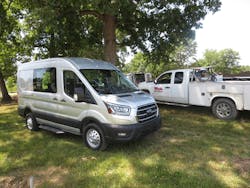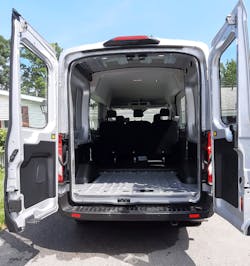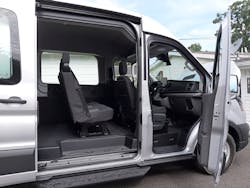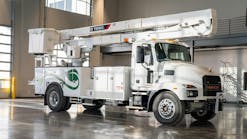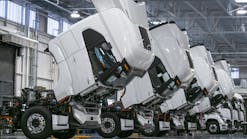What’s this van doing at a construction site? Aside from excavators, dozers, and other yellow machinery, job sites tend to be populated by pickup trucks. They haul the tools, equipment, and materials to where they’re needed, and these days do it with style and comfort. A Ford Transit van just might do all of that and in some ways do it better. You say your pickup’s a crewcab that will carry extra people, and it’s got 4-wheel drive? So does this Transit. It’s got optional crew seating, a 3-person bench seat accessible from the sliding side door, and all-wheel drive that will take it over slippery surfaces, though not rough terrain. Those are new options for the 2020 Transit, and Ford sent this one down from Dearborn, Michigan, so I could check them out.
Using enhanced telematics, another feature Ford is promoting with the Transit and other vehicles, the trip it took from Michigan to central Ohio could be tracked and the driver’s behavior monitored. Those watching saw on a Google-generated map that the driver had stopped at a Tim Horton’s restaurant, apparently for breakfast, and gave me an estimated time of arrival, which proved accurate. Travis Hunt, program manager for telematics at Ford Commercial Fleet, showed me the record it had generated along the way, and observed several instances of possible concern, like the van traveling 71 mph in a 65 mph zone and a harsh braking incident: okay if it’s an isolated thing but possible cause for counseling if it appears to be a driver’s habit.
In a video conference, Hunt also showed me where the Transit was parked overnight—in the driveway behind my house—and explained that an alert might be generated if, in violation of company rules, I had taken the truck out after normal business hours. Well, I did, to the county fairgrounds across the street to pose it for some photos. On the map I could see the paths the van followed for that. “Big Brother”? Maybe, but “the two most expensive things a fleet owner has are his trucks and the people who drive them,” Hunt said. Knowing where the truck is and how it’s being driven is important to the safety of both those assets.
“Telematics can give a lot of insights into how a vehicle is being operated,” he said. “One customer told us he went into telematics because on one of his trucks, the check engine light had been on for two weeks and the driver never said anything about it. The engine cratered for lack of maintenance. ‘If I had known that light was on, I could have pulled the truck in to check it out,’ the customer said.” Fluid levels, suggested oil change intervals, and other maintenance data can be displayed so the manager can schedule trucks for work. All are recorded and transmitted to Ford’s cloud, and the fleet manager can access the data later.
Back to the truck itself. Ford has been building and selling Transits in Europe since 1965. They’re generally taller, wider, and use smaller powertrains than the E-series built here. Ford brought the Transit to North America in 2015, where it’s replaced the E-series van (though cutaway cab-chassis versions are still available). Our Transit is Americanized with certain safety and emissions systems, and is built in the USA. Like other Ford commercial vehicles, the Transit has undergone continuous improvement, with the latest telematics being an example.
Another is all-wheel drive, a $4,500 feature that is proving popular in northern states and across Canada, related Ray Eyles, chief program manager, “and in Florida, strangely enough.” I suggested it might be due to sandy soil found there. The AWD system is adapted from that on the Explorer SUV, and it uses a single-speed transfer case that continuously sends power to both axles.
“It’s not a manual control,” Eyles said. “You don’t have to stop and engage the four-wheel drive system. It’s just always on, and it’s sending torque to the front wheels or the rear wheels, depending on what’s required.” An AWD Transit can chug through deep snow and tip toe confidently over slick pavement, and can venture off pavement to some extent. Customers said they didn’t want a high ride height, and the height with this is the same as with two-wheel drive. Floor height on this Transit was about 2 feet, and entering and exiting the truck was a little awkward for me. Taller drivers will find it easier. Climbing into and out of the passenger seat is similar, and passengers using the rear seat have an external running board to use.
To me, the Transit van’s biggest advantage over a pickup is all the stuff you can store. All the tool boxes bolted into and onto the beds of some pickups could become shelves, bins, and chests under the roof. They’ll stay dry and what’s in them will be easy to reach because Euro-style vans allow you to hop in and stand up while you select the stuff you need. The ceiling of this mid-roof Transit was about 69 inches high, measured at roof bows, enough for me to walk upright in. There are also versions with taller and shorter roofs, and the Transit line is available in several body lengths and wheelbases. While I was taking pics at a nearby construction site, a couple of guys came over to see what I was doing and I showed them the van. They were impressed, but noted that a heavy duty pickup can pull a gooseneck equipment trailer while a van couldn’t. Agreed, but a trailer with a regular tongue could be handled.
My driving time with the Transit was brief but enjoyable. It rode firmly but well, even over some rough city streets, and its turning circle was small. And this thing scooted. Under the short hood was a 3.5-liter (214-cubic-inch) V-6 that was so gutsy that I thought it was turbocharged, but it turned out to be the latest PFDI (port fuel direct-injected) configuration, with 275 horsepower and 262 lb.-ft. of torque.
The truck was empty, but I think it would be more than adequate even with a heavy load. It ran through a 10-speed automatic transmission, the only gearbox available, which upshifted smoothly but occasionally downshifted with a muted thump. Turned out the engine was not turbocharged, but this truck was a T-250, so payload was 3,670 pounds and GVW is listed at 9,070 pounds. The two gasoline V-6s are the only engines available. A four-cylinder 2-liter diesel was initially offered, but Eyles said it has been dropped for lack of customer interest. So unlike big pickups, there are no diesel bragging rights with this van.
